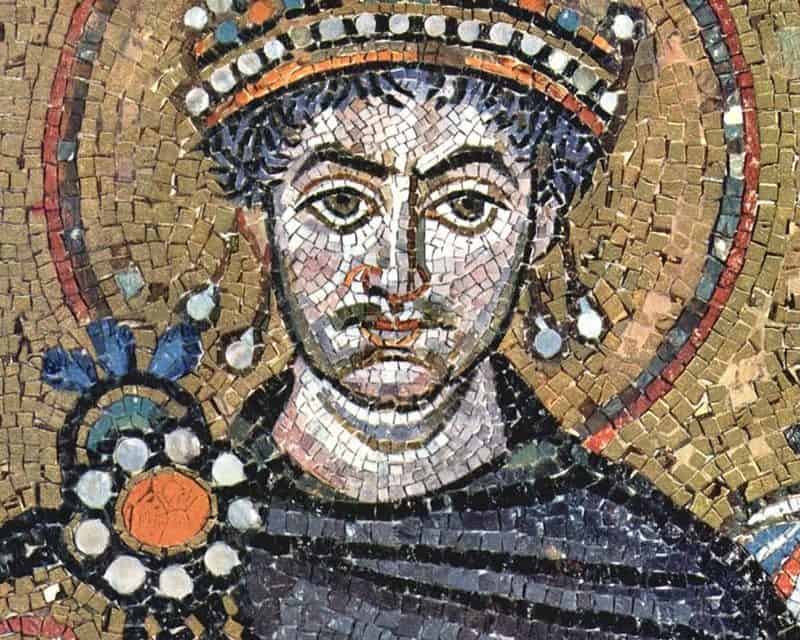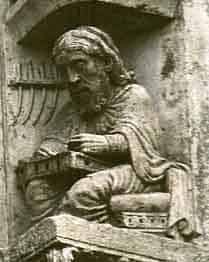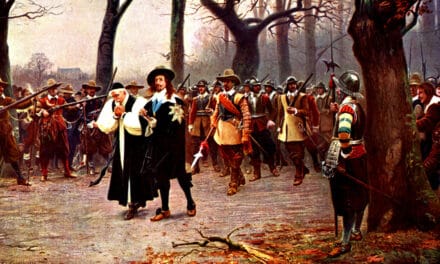This week’s episode of Communion Sanctorum is titled – “Justinian Sayin’”
During the 5th C, while the Western Roman Empire was falling to the Goths, the Eastern Empire centered at Constantinople looked like it would carry on for centuries. Though it identified itself as Roman, historians refer to the Eastern region as the Byzantine Empire & Era. It gets that title from Byzantium, the city’s name before Constantine made it his new capital.
During the 5th C, the entire empire, both East & West went into decline. But in the 6th Century, the Emperor Justinian I lead a major revival of Roman civilization. Reigning for nearly 40 years, Justinian not only brought about a re-flowering of culture in the East, he attempted to reassert control over those lands in the West that had fallen to barbarian control.
A diverse picture of Justinian the Great has emerged. For years the standard way to see him was as an intelligent, ambitious, energetic, gregarious leader plagued by an unhealthy dose of vanity. Dare I say it? Why not: He wanted to make Rome Great Again. While that’s been the traditional way of understanding Justinian, more recently, that image has been edited slightly by giving his wife and queen Theodora, a more prominent role in fueling his ambition. Whatever else we might say about this husband and wife team, they were certainly devout in their faith.
Justinian’s reign was bolstered by the careers of several capable generals who were able to translate his desire to retake the West into reality. The most famous of these generals was Belisarius, a military genius on par with Hannibal, Caesar, & Alexander. During Justinian’s reign, portions of Italy, North Africa & Spain were reconquered & put under Byzantine rule.
The Western emperors in Rome’s long history tended to be more austere in the demonstrations of their authority by keeping their wardrobe simple & the customs related to their rule modest, as befitted the idea of the Augustus as Princeps = meaning 1st Citizen. Eastern emperors went the other way & eschewed humility in favor of an Oriental, or what we might call “Persian” model of majesty. It began with Constantine who broke with the long-held western tradition of Imperial modesty & arrayed himself as a glorious Eastern Monarch. Following Constantine, Eastern emperors wore elaborate robes, crowns, & festooned their courts with ostentatious symbols of wealth & power. Encouraged by Theodora, Justinian advanced this movement and made his court a grand showcase. When people appeared before the Emperor, they had to prostrate themselves, as though bowing before a god. The pomp and ceremony of Justinian’s court were quickly duplicated by the church at Constantinople because of the close tie between church & state in the East.
It was this ambition for glory that moved Justinian to embark on a massive building campaign. He commissioned the construction of entire towns, roads, bridges, baths, palaces, & a host of churches & monasteries. His enduring legacy was the Church of the Holy Wisdom, or Cathedral of St. Sophia, the main church of Constantinople. The Hagia Sofia was the epitome of a new style of architecture centered on the dome, the largest to be built to that time. Visitors to the church would stand for hours in awe staring up at the dome, incredulous that such a span could be built by man. Though the rich interior façade of the church has been gutted by years of conflict, the basic structure stands to this day as one of Istanbul’s premier attractions.
Justinian was no mean theologian in his own right. As Emperor he wanted to unite the Church under one creed and worked hard to resolve the major dispute of the day; the divide between the Orthodox faith as expressed in the Council of Chalcedon & the Monophysites.
By way of review; the Monophysites followed the teachings of Cyril of Alexandria who’d contended with Nestorius over the nature of Christ. Nestorius emphasized the human nature of Jesus, while Cyril emphasized Jesus’ deity. The followers of both took their doctrines too far so that the Nestorians who went East into Persia tended to diminish the deity of Christ, while the Cyrillians who went south into Egypt, elevated Jesus’ deity at the expense of his humanity. They put such an emphasis on his deity they became Monophysites; meaning 1 nature-ites.
Justinian tried to reconcile the Orthodox faith centered at Constantinople with the Monophysites based in Egypt by finessing the words used to describe the faith. Even though the Council of Chalcedon had officially ended the dispute, there was still a rift between the Church at Constantinople and that in Egypt.
Justinian tried to clarify how to understand the natures of Jesus as God & Human. Did He have 1 nature or 2? And if 2. How did those 2 natures co-exist in the Son of God? Were they separate & distinct or merged into something new? If they were distinct, was one superior to the other? This was the crux of the debate the Council of Chalcedon had struggled with and which both Cyril & Nestorius contended over.
Justinian had partial success in getting moderate Monophysites to agree with his theology. He was helped by the work of a monk named Leo of Byzantium. Leo proposed that in Christ, his 2 natures were so co-mingled & united so that they formed one nature, he identified as the Logos.
In 544 Emperor Justinian issued an edict condemning some pro-Nestorian writings. Many Western bishops thought the edict a scandalous refutation of the Chalcedonian Creed. They assumed Justinian had come out as a Monophysite. Pope Vigilius condemned the edict and broke off fellowship with the Patriarch of Constantinople because he supported the Emperor’s edict. Shortly thereafter, when Pope Vigilius visited Constantinople, he did an abrupt about-face, adding his own censure to the condemned pro-Nestorian writings. Then in 550, after several bishops criticized this reversal, Vigilius did another & said the writings weren’t prohibited after all.
Nothing like being a stalwart pillar of an unwavering stand. Vigilius was consistent; he consistently wavered when under pressure.
All of this created so much controversy that in 553 Justinian called the 5th Ecumenical Council at Constantinople. Though it was supposed to be a counsel of the whole church, Pope Vigilius refused to attend. At Justinian’s demand, the Council affirmed his original edict of 544, further condemning anyone who supported the pro-Nestorian writings. The Emperor banished Vigilius for his refusal to attend, saying he would be reinstated only on condition of his accepting the Council’s decision.
Guess what Vigilius did. Yep. He relented and endorsed the Council’s finding. So the result was that the Chalcedonian Creed was reinterpreted along far more Monophysite lines. Jesus’ deity was elevated to the foreground while his humanity was relegated to a distant backwater. This became the official position of the Eastern Orthodox Church.
But Justinian’s desire to bring unity wasn’t achieved. The Western bishops refused to recognize the Council of Constantinople’s interpretation of the Chalcedon Creed. And while the new spin on Jesus’ nature was embraced in the East, the hard-core Monophysites of Egypt stood their ground. They’d come to hold their theology with a fierce regional loyalty. To accept Justinian’s formulation was deemed a compromise they saw not only as heretical but as unpatriotic. They vehemently refused to come under the control of Constantinople.
What Justinian was unable to do by theological compromise and diplomacy, he attempted, by force. After all, as they say, a War is just diplomacy by other means. And as Justinian might say, “What good is it being King if you can’t bash heads whenever you want?”
The Emperor also sought to eradicate the last vestiges of paganism throughout the Empire. He commanded both civil officials & church leaders to seek out all pagan cultic practices and pre-Christian Greek philosophy and bring an immediate end to them. He closed the schools of Athens, the last institutions teaching Greek philosophy. He allowed the Jews to continue their faith but sought to regulate their practices. He decreed the death penalty for Manichaeans and other heretics like the Montanists. When his harsh policies stirred up rebellion, he was ruthless in putting it down.
Toward the end of his reign, his wife Theodora’s Monophysite beliefs influenced him to move further in that direction. He sought to recast the 5th Council’s findings into a new form that would gain greater Monophysite support. This new view has been given the tongue-twisting label of Aph-thar-to-docetism.
According to this view, even Jesus’ physical body was divine so that from conception to death, it didn’t change. This means Jesus didn’t suffer or know the desires & passions of mortals.
When he tried to impose this doctrine on the Church, the vast majority of bishops refused to comply. So Justinian made plans to enforce compliance but died before the campaign could begin, much to the relief of said bishops.
Justinian took an active hand in ordering the Church in more than just theology. He passed laws dealing with various aspects of church life. He appointed bishops, assigned abbots to monasteries, ordained priests, managed church lands and oversaw the conduct of the clergy. He forbade the practice of simony; the sale of church offices. Being a church official could be quite lucrative, so the practice of simony was frequently a problem.
The Emperor also forbade the clergy from attending chariot races and the theater. This seems harsh if we think of these as mere sporting and cultural events. They weren’t. Both events were more often than not scenes of moral debauchery where ribald behavior was common. One did not attend a race for polite or dignified company. The races were à well, racy. And the theater was a place where perversions were enacted onstage. That Justinian forbade clergy from attending these events means had been common for them to do so.
He authorized bishops to function in a quasi-civil fashion by having them oversee public works and enforcing laws against vice. In some places, bishops served as governors.
It was under Justinian that the church became an instrument of the state. That process had begun under Constantine but it wasn’t until the 6th C under Justinian that it reached its zenith.
Christianity continued to extend its influence along the borders of the Empire. With the re-conquest of North Africa, the Arianism that had taken root there was eradicated. The Faith moved up the Nile into what today we know as Sudan. The Berbers of North Africa were also converted. In Europe, Barbarian tribes along the Danube were reached.
The divide between Monophysites & Orthodox Justinian had tried to heal continued to plague the church into the 7th C when a new thread emerged; Islam.
Emperor after emperor knew a fragmented church meant a weakened society which would be easy prey to the new invaders. So they worked feverishly to bring about theological unity.
Let’s see – how do we bring the Orthodox & Monophysites together?
Sergius, the Patriarch of Constantinople had an idea. Based on what were thought to be the writings of one of the early church fathers named Dionysis, Sergius thought he found support for a new idea that could reconcile the two sides. He said that while Jesus was both divine & human, He worked by only one energy. This sounded great to the Monophysites of Egypt and for a time it looked like there would be unity. But other bishops cried foul, so Sergius quickly shifted ground and said, “Okay, forget the one energy deal and how about this; Christ was both divine & human but possessed only one will which was a merging of the 2 natures.” Pope Honorius put his stamp of approval on this view & now with the agreement of the 2 most influential churches, it looked like a theological slam-dunk. So in 638, Emperor Heraclius passed an edict expressing Sergius’ views and forbidding further debate.
The Emperor passed an edict – so that settles it right? >> Not quite.
When Pope Honorius died, the next pope announced Jesus had two wills. Oh, & furthermore – that was the real position of Honorius – he’d just been misunderstood by Patriarch Sergius. Each Pope thereafter affirmed Jesus’ divine & human wills as distinct though in harmony with each other. This view held sway in the West as opposed to Sergius’ view which became the position of the East.
When in 648 the issue threatened to once again tear the church & Empire in 2, Emperor Constans II declared all debate about 1 or 2 wills or energies, off-limits. But wouldn’t you know it – when word of the ban reached Rome a year later, Pope Martin I called a synod to discuss the issue; decided Jesus had 2 wills and denounced the patriarch of Constantinople. The bishops also said, “How dare the Emperor tell us what we can and can’t talk about!”
Constans II decided to show the Pope how he dared and had him arrested & hauled to the capital where he was condemned, tortured, and banished. Martin died in exile.
Then a funny thing happened. Not funny really – tragic more like. North Africa, that region of the Empire that had been so fastidiously devoted to Monophytism was conquered by Islam. And suddenly the debate lost its main voice. So Constantine IV, called a 6th Ecumenical council, again in Constantinople in 680. This council officially declared the idea of one energy & one will in Christ heretical. Jesus had 2 wills; one divine, the other human. The Council claimed its views were in accord with a similar council held in Rome a year before under the auspices of Pope Agatho.
Most Church historians consider the 6th Council to be the last at which the nature of Jesus was the primary theological consideration. To be sure, the Nestorians continued to spread Eastward as they made their way to China and there were still pockets of monophytism in Egypt, but in both the Eastern & Western regions of the Empire, Orthodoxy or what is often called Catholic Christianity now held sway.






Awesome stuff. I found some lectures on Christian history in the form of free podcast downloads. Those were good, but not near as comprehensive and as well done as yours. Thanks for making my commute less crummy!
Lakewood, CO
(Parishioner of Scum of The Earth Church–Denver)
Thanks Ben; much appreciated.